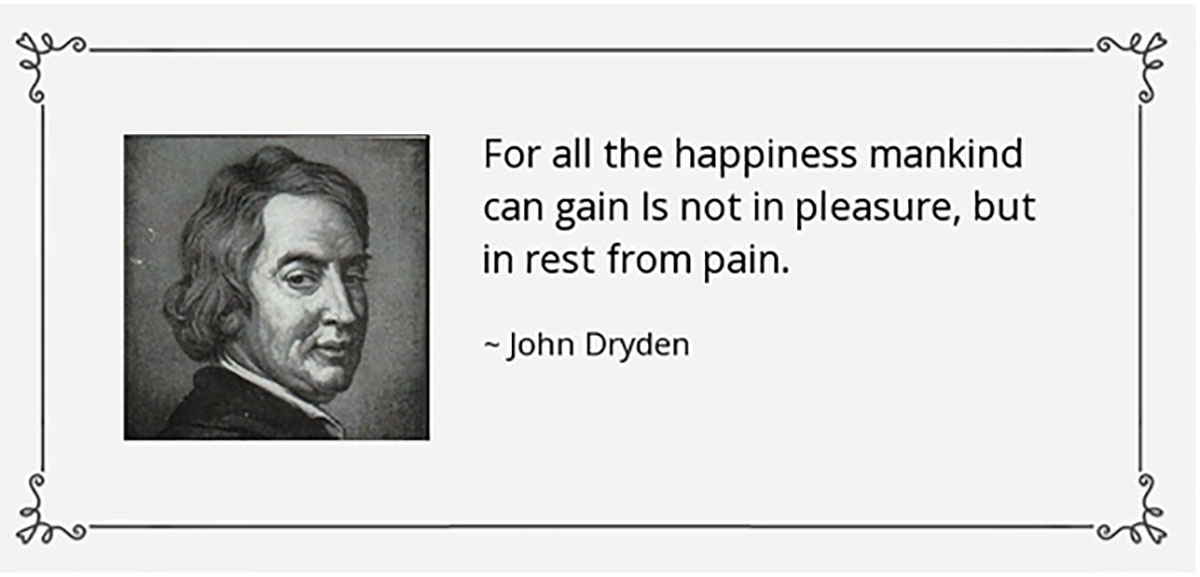Pain is an experience one is never in doubt about having. One might ask, “Am I in love?” But never “Am I in pain?”1 Indeed, pain is inevitable to mankind. However, is pain just an idea, a sensation, emotion, or a feeling?
In 1931, nobel laureate Albert Schweizer said that “Pain is a more terrible lord of mankind than ever death itself”. This statement was published as an opening sentence of the book “Bonica’s Management of Pain” printed 22 years after Schweizer have spoken about it. Until now, pain management remains one of the most important issues of the society in general, as well as scholars and medical professionals.
Pain is a major problem all around the world. It impairs the ability to work and have a productive life because pain disables, disturbs, and it has serious economic, social, or financial consequences. For example, statistics show that back pain is one of the most common reasons for missed work. In fact, back pain is the second most common reason for visits to the doctor’s office.
Why Do We Need Pain Management Clinics Then?
Our minds are set to marvel and search for solutions to problems. When we feel pain, we seek treatment. Like what John Dryden said, “For all happiness mankind can gain is not in pleasure, but in the rest from pain.”

A pain management clinic is a place of convergence for all patients experiencing pain irrespective of the etiology of pain, as well as the presenting signs and symptoms. One can go to the hospital and complain of acute pain due to trauma or accidents and immediately, the medical staff will treat its organic or physiological cause such as broken bones or vessels. When confronted with chronic pain, on the other hand, implications on the body and mind are also being unraveled. Pain management clinic offers different kinds of treatments to individuals depending on the severity and the nature of the pain. The only criterion is that you have to go to the clinic and report of experiencing pain.
Benefits of Pain Management Clinics
- Provides Variety of Strategies for Pain Management
Pain management clinics have different providers that are likely to include physicians as well as non-doctor providers such as physical therapist, acupuncturists, massage therapists and alternative therapists. Together they can work towards one goal—to lessen your pain or make you pain free.
- Reduced Cost of Care
Pain management clinics offer most efficacious and low-cost therapies and treatments for persons with different pain complaints, relative to a host of widely used programs offered in the hospitals and other facilities. Some clinics offer discounts to uninsured/cash-paying clients, and some offer natural treatment methods, which are cost-effective depending on the cause of pain and its effects.
- Provides Focused Treatment
A pain management clinic is a health care facility that makes therapy plans tailored to the diagnosis, management, and treatment of your chronic pain needs. Some even specialize in specific diagnoses like ‘Sports Injury Clinics’ or in pain related to a specific region of the body such as ‘Back Pain Clinics’. Programs offered are focused on the total person, not just the pain.
- Further Benefits to the Community
Our health care system nowadays is not financially sustainable. To save the resources in the country, acknowledgement of other aspects of health should be given attention as well.
In the past few decades, when people complain of pain, diagnostic procedures were automatically ordered. Example, when one complains of back pain, an x-ray will be done, then possibly an MRI and so on. However, some pain disorders are not associated with a general medical condition. Sometimes pains are caused by stress, emotional imbalance, or social dysfunctions that may play a role in the perception of pain.
With pain management clinics, a holistic interdisciplinary treatment is offered which cuts the healthcare costs.
Pegasus Pain Management… SET YOUR PAIN FREE!
Pegasus Pain Management is a fully integrated, comprehensive pain management clinic with state-of-the-art equipment available in the clinic. Alik Saidov, MD, prides himself in having a professional, experienced team of certified healthcare specialist who attend to patients in a compassionate, low-stress environment. For patients with chronic pain, Dr. Saidov’s approach is multidisciplinary. He works closely with many other specialists including neurologists, psychologists, orthopedic and spine surgeons, physiatrists, pain psychologists, and psychiatrists to optimally coordinate the care of our patients. Dr. Saidov is an avid cyclist and body builder and has competed on an international level. He understands the importance of returning his patients to optimal function and performance.
References:
1 Excerpt from the book The Pain Chronicles. Thernstrom, M. (2010). The pain chronicles: Cures, myths, mysteries, prayers, diaries, brain scans, healing, and the science of suffering. New York: Farrar, Straus and Giroux.
Retrieved November 1, 2016, from https://medind.nic.in/iad/t06/i5/iadt06i5p408.pdf
Retrieved October 31, 2016, from https://www.chronicpainperspectives.com/articles/feature-article/article/the-benefits-of-interdisciplinary-pain-management/2cea1371420ebb0f984087047710c865.html?tx_ttnews%5BsViewPointer%5D=1
Pain clinics – what are they & what do they do? (2016). Retrieved October 31, 2016, from https://www.rsdhope.org/pain-clinics—what-are-they–what-do-they-do.html
Association, C. A. C. (2016). Back pain facts and statistics. Retrieved October 31, 2016, from https://www.acatoday.org/Patients/Health-Wellness-Information/Back-Pain-Facts-and-Statistics
Retrieved October 31, 2016, from https://www.mountsinai.on.ca/care/mount-sinai-function-and-pain-program/Cost%20effectiveness%20of%20comprehensive%20pain%20programs.pdf
Oyama, O., Paltoo, C., & Greengold, J. (2007, November 1). Somatoform disorders. Retrieved October 31, 2016,, from https://www.aafp.org/afp/2007/1101/p1333.html
Images:
Retrieved October 31, 2016,, from https://thegoodbody.thegoodbody.netdna-cdn.com/wp-content/uploads/2016/04/Approximately-8-out-of-Every-10-Americans-Will-Experience-a-Back-Problem-at-Some-Point-During-Their-Lifetimes.png
